According to Global Market Insights the electro-optic systems market was valued at USD 12.6 billion in 2022 and is projected to grow at a CAGR of 5.5% to reach USD 20 billion by 2032. Advanced imaging and sensing technologies are driving this growth, especially in surveillance, healthcare, and telecommunications.

Electro-optic systems use electrical signals to control optical properties and are integral to modern applications such as communications, imaging, and sensing. These systems include a range of devices and technologies, including Lasers, LEDs, Cameras, LIDAR, and more.
One of the most important components of these electro-optic systems is the electro-optic cell (EO). Among the materials used in EO cells, RTP (Rubidium Titanyl Phosphate) crystals stand out. RTP crystals belong to the KTP (Potassium Titanyl Phosphate) family and are used in electro-optic applications because of their unique properties.
In this article, we will explore the critical role of electro-optic systems in modern technology, focusing on RTP (Rubidium Titanyl Phosphate) crystals, their benefits, technical specifications, and their applications.
RTP Crystals: The Core of Advanced EO Cells
Rubidium Titanyl Phosphate (RTP), chemically known as RbTiOPO(_4), is an isomorph of the well-known Potassium Titanyl Phosphate (KTP) crystal. Both RTP and KTP belong to the same crystal family and share similar structural properties, ideal for nonlinear and electro-optic applications.
RTP crystals have several unique properties that make them highly advantageous for electro-optic applications:
- High Damage Threshold: RTP crystals can withstand high laser power densities, approximately 1.8 times higher than KTP, making them suitable for high-power laser systems.
- High Resistivity: They offer high electrical resistivity, which is beneficial for maintaining performance stability under varying electrical conditions.
- Non-Hygroscopic: Unlike some other crystals, such as KDP or Rb KD*P, RTP is non-hygroscopic, meaning it does not absorb moisture from the air. This property contributes to its durability and reliability in various environmental conditions.
- No Piezoelectric Effect: RTP exhibits negligent piezoelectric effect, which can cause unwanted mechanical vibrations in some applications.
- Wide Temperature Range: The unique design structure performs well over a broad temperature range, from -50°C to +70°C, providing consistent performance in different environments.
- Low Half-Wave Voltage: RTP crystals require a lower voltage to achieve half-wave retardation, which is crucial for compact and efficient electro-optic devices.
- High Repetition Rates: Supports high repetition rates, making them ideal for fast switching and modulation applications.
Due to these properties, RTP crystals are widely used in various electro-optic applications, including Q-Switches, Amplitude and Phase Modulators, Pulse Pickers, and Fast Shutters.
Structure and Design of RTP EO Cells
Raicol’s RTP EO cells are designed using a thermally compensated double-crystal configuration. This involves placing two matched RTP crystals in line with the propagation axis (either X or Y axis), with one crystal rotated by 90 degrees relative to the other.
This configuration helps to balance thermal effects, ensuring stable performance across a wide temperature range.
Crystal Orientation and Its Benefits
The specific orientation of the crystals in this configuration offers several benefits:
- Thermal Compensation: By rotating one crystal by 90 degrees, the thermal expansion effects in one crystal are counteracted by the other, minimizing thermal drift and maintaining consistent performance.
- Improved Stability: This orientation ensures that the electro-optic properties remain stable over a wide temperature range, from -50°C to +70°C.
- Improved Homogeneity: The matched pair configuration enhances the homogeneity of the electro-optic effect, allowing for larger cell sizes and more uniform performance.
- Reduced Piezoelectric Effect: RTP has no ringing effect up to 1MHz and can be used with rep rates way above 1MHz
- High Repetition Rates: The configuration supports high repetition rates, making it suitable for applications requiring fast switching and modulation.
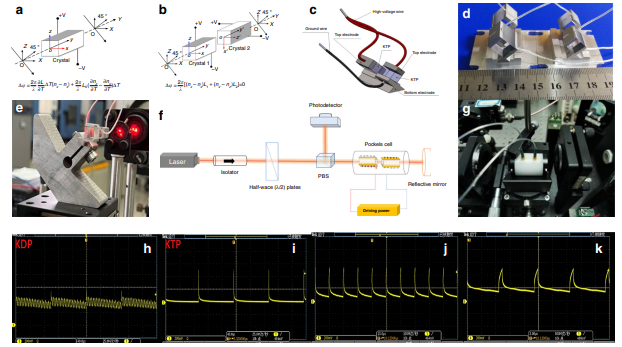
These design features make Raicol’s RTP EO cells highly reliable and efficient for advanced electro-optic applications, ensuring optimal performance in various demanding environments.
Advantages of Raicol's RTP EO Cells
Raicol’s RTP (Rubidium Titanyl Phosphate) EO (Electro-Optic) cells offer several significant advantages for advanced electro-optic applications:
- Fast Operation: These cells provide sub-nanosecond response times, providing rapid operation for high-speed applications.
- Wide Temperature Stability Range: RTP EO cells are designed to operate effectively over a wide temperature range, from -50°C to +70°C, providing reliable performance.
- High Laser-Induced Damage Threshold: They can withstand high laser power densities, with a damage threshold of up to 1 GW/cm² at 1064 nm, making them ideal for high-power laser systems.
- Minimal Ringing: The cells exhibit minimal ringing, which is crucial for maintaining high repetition rates, compatible with over 1 MHz repetition rate.
- Low Half-Wave Voltage: RTP EO cells’ low half-wave voltage allows for a compact design, making them suitable for integration into smaller devices.
- Non-Hygroscopic Nature: RTP crystals are non-hygroscopic, meaning they do not absorb moisture from the air. This property simplifies handling and storage, as no special covers are needed.
- Superior Performance in the 400-3000 nm Spectral Range: RTP EO cells perform exceptionally well across a broad spectral range, making them versatile for various optical applications.
- Low Absorption Losses at 1064 nm: They have very low absorption losses at the common laser wavelength of 1064 nm, leading to efficient operation.
- High Homogeneity: RTP crystals offer high homogeneity, allowing for the production of large cell sizes, up to 15 x 15 mm² as a standard size.
These advantages make Raicol’s RTP EO cells a preferred choice for applications requiring high performance, reliability, and efficiency.
Applications of RTP EO Cells
RTP (Rubidium Titanyl Phosphate) EO cells are flexible components used in various advanced electro-optic applications due to their unique properties.
Here are some key applications:
Q-Switches and Pulse Pickers
RTP EO cells are used in active Q-switches to control the timing of laser pulses, enabling the generation of high-intensity, short-duration laser pulses. They are also used in pulse pickers to select specific pulses from a train of laser pulses, which is essential for applications requiring precise pulse control.
Phase and Amplitude Modulators
RTP EO cells can modulate the phase of a laser beam, which is crucial for applications like laser stabilization, mode-locking and coherent beam combining (CBC). These cells also control the intensity of laser beams, making them suitable for applications in optical communication and signal processing.
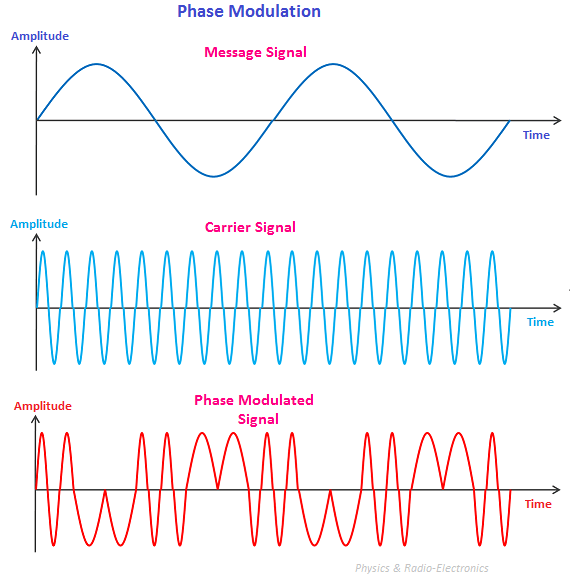
Cavity Dumpers and Shutters
RTP EO cells are used in cavity dumpers to rapidly extract energy from a laser cavity, allowing for the generation of high-energy pulses. They act as fast shutters to quickly block or unblock laser beams, which is important for applications requiring precise control of laser exposure.
Attenuators and Deflectors
RTP EO cells can lower the intensity of laser beams, providing adjustable control over the laser power. They also deflect laser beams, enabling precise beam direction and alignment in various optical systems.
Integrated Quantum Photonics and Quantum Computing [ 2 ]
Some other emerging trends in photonics include integrated quantum photonics and quantum computing, which make use of EO technologies for improved information processing and quantum functionality.
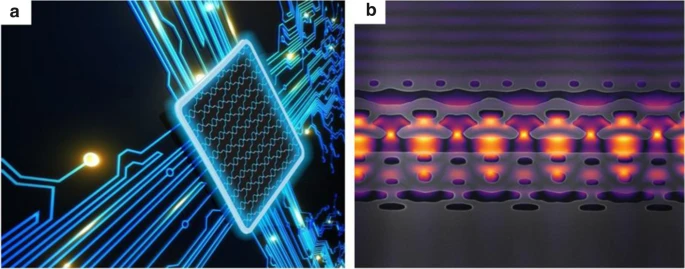
Photonic Integrated Circuits [1]:
Similar to other EO materials RTP can be in a thin film on insulator wafer and enhance performance compared to similar materials. For example, LTOI wafers offer scalable manufacturing at low cost while exhibiting properties similar or superior to lithium niobate-on-insulator (LNOI) wafers. They are used to create high-speed, low-voltage EO modulators and soliton microcombs for high-speed optical communication.
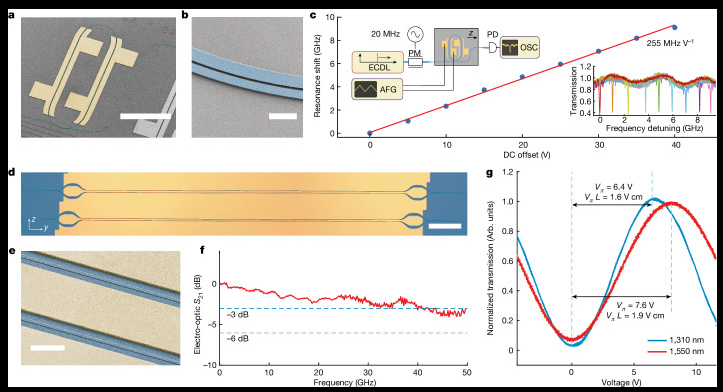
A recent study published in Physics Today [3] discusses the potential of integrating nonlinear optical frequency conversion with EO tunability to improve the performance of integrated photonics. This integration allows for the development of advanced photonic devices that can achieve high-speed data transmission, low power consumption, and enhanced quantum functionality.
Key Findings:
- Nonlinear Optical Frequency Conversion: This technique involves converting the frequency of light to different wavelengths, which is crucial for applications in telecommunications and quantum computing.
- EO Tunability: The ability to tune the optical properties of materials using electrical signals improves the flexibility and functionality of photonic devices.
Raicol’s RTP (Rubidium Titanyl Phosphate) crystals can be integrated into these advanced EO systems to enhance their performance. Here’s how professionals can use Raicol’s materials in light of these new developments:
- In Silicon Photonics:
- High-Speed Modulators: RTP crystals can be used to create high-speed modulators with low half-wave voltage, improving the efficiency and compactness of photonic integrated circuits.
- Increased Data Transmission: The high damage threshold and wide temperature stability range of RTP crystals make them ideal for use in high-power EO modulators, facilitating high-speed data transmission.
- In Nonlinear Optical Devices:
- Frequency Conversion: RTP crystals’ ability to withstand high laser power densities, low absorption losses and high homogeneity makes them suitable for nonlinear optical frequency conversion applications, enhancing the versatility of photonic devices.
- Quantum Computing: Low absorption losses and high repetition rates of RTP crystals can enhance the reliability and speed of devices used in quantum computing.
- In Plasmonic-Organic Hybrid (POH) Devices:
- Ultrafast Modulation: Improve the performance of POH devices, enabling ultrafast modulation speeds.
Due to these properties, RTP crystals are widely used in various electro-optic applications, including Q-Switches, Amplitude and Phase Modulators, Pulse Pickers, and Fast Shutters.
Technical Specifications
RTP (Rubidium Titanyl Phosphate) EO cells are designed to meet the demanding requirements of various electro-optic applications.
Here are some typical specifications:
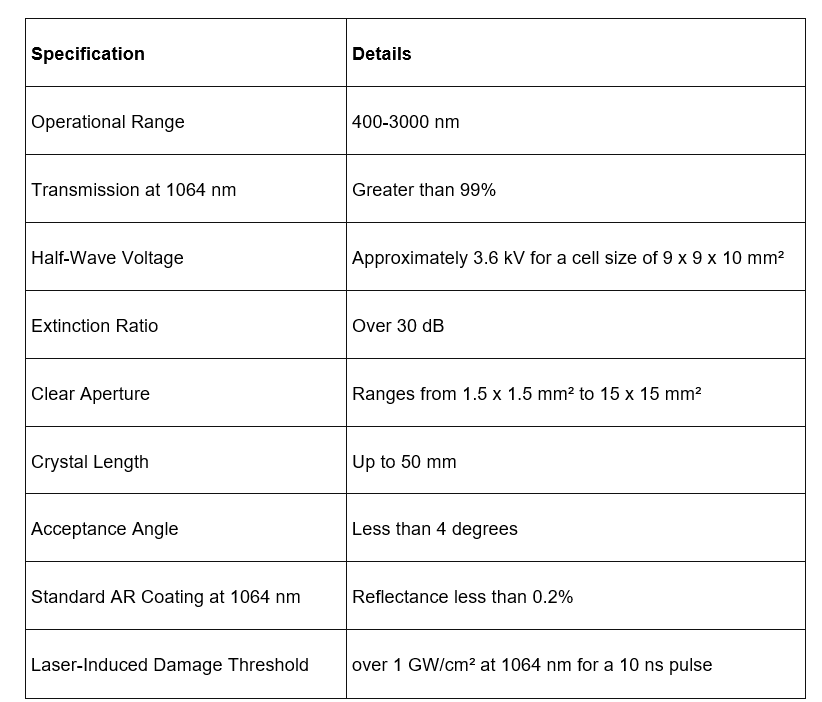
Key Performance Metrics
- Operational Range: RTP EO cells operate effectively across a broad spectral range of 400-3000 nm, making them versatile for various optical applications.
- Transmission: They exhibit high transmission rates, with over 99% transmission at the common laser wavelength of 1064 nm, ensuring efficient light passage.
- Half-Wave Voltage: The low half-wave voltage of around 3.6 kV allows for compact and efficient device designs. Different designs allow to reduce the HWV even more.
- Extinction Ratio: With an extinction ratio of over 30 dB, RTP EO cells provide excellent modulation depth, which is crucial for high-contrast applications.
- Clear Aperture: The large clear aperture options, up to 15 x 15 mm², enable the handling of larger beams and higher power levels.
- Laser-Induced Damage Threshold: The high damage threshold of over 1 GW/cm² at 1064 nm ensures durability and reliability in high-power laser systems1.
- Temperature Stability: Designed to operate over a wide temperature range from -50°C to +70°C, RTP EO cells maintain stable performance in various environmental conditions.
- Low Absorption Losses: Very low absorption losses at 1064 nm enhance the efficiency and performance of the EO cells.
Raicol Crystals’ Expertise and Offerings
Raicol Crystals is renowned for its pioneering work in the development and production of high-quality nonlinear optical crystals, including:
- RTP (Rubidium Titanyl Phosphate): Known for its high damage threshold and excellent electro-optic properties.
- HGTR KTP (High Gray Track Resistant Potassium Titanyl Phosphate): Offers enhanced resistance to grey tracking, making it suitable for high-power applications.
- PPKTP (Periodically Poled Potassium Titanyl Phosphate): Widely used in quantum optics and nonlinear frequency conversion applications.
Complete In-House Production Capabilities
Raicol Crystals has a modern manufacturing facility serves as a one-stop shop for high-quality crystal production. Their in-house capabilities include:
- Crystal Growth: Over 200 crystal growth stations equipped with proprietary growth systems.
- Optical Fabrication: Advanced cutting, polishing machines, and clean rooms ensure precise and high-quality optical components.
- Coating Facilities: In-house AR, DBAR, and BBAR coating capabilities for various wavelengths and applications.
- Testing and Quality Control: Comprehensive testing equipment, including interferometers, spectrophotometers, and laser damage threshold testers, to ensure product reliability and performance.
Flexibility in Production Scale and Fast Delivery Times
Raicol Crystals offers flexibility in production scale, adapting to both mass production and small R&D volumes. Their efficient production processes and extensive experience enable them to provide quick turnaround times to meet customer demands and tailor products to meet specific customer requirements.
These capabilities and offerings make Raicol Crystals a leader in nonlinear optical crystals and electro-optic components, providing reliable and high-performance solutions for various applications.
Conclusion
RTP (Rubidium Titanyl Phosphate) EO (Electro-Optic) cells significantly improve the performance of electro-optic systems by offering superior speed, rates and efficiency. These cells are known for their high damage threshold, ensuring durability and reliability in high-power applications.
Raicol Crystals, a leading provider, offers high-quality RTP EO cells that meet stringent industry and defense standards. Known for innovation and reliability, they serve various industries globally with customized solutions and continuous product improvements through research and development.
References
- Wang, C., et al. (2024). Lithium tantalate photonic integrated circuits for volume manufacturing. Nature, 629, 784–790. Access here
- Chen, Z., Segev, M. Highlighting photonics: looking into the next decade. eLight 1, 2 (2021). https://doi.org/10.1186/s43593-021-00002-y
- 2https://digital.physicstoday.org/physicstoday/august_2023/MobilePagedArticle.action?articleId=1899999#articleId1899999
Do you have a question? Our experts will be happy to hear from you and advise you on the best product for you. Contact Us.
Author: Dr. Noa Voloch Bloch and Ori Levin
Difference Frequency Generation (DFG) and Sum Frequency Generation (SFG) are crucial processes in modern laser systems, allowing for the generation of new optical frequencies by mixing two distinct wavelengths. For professionals in industries such as defense, aerospace, medical, and industrial applications, selecting the right nonlinear crystal is critical to achieving optimal performance.
With over 50 years of experience in crystal growth, Raicol Crystals is at the forefront of providing high-quality nonlinear optical crystals and electro-optical components for laser systems worldwide. In this article, we will explore key aspects of DFG and SFG and how Raicol’s expertise in crystal manufacturing can significantly enhance the efficiency and precision of your laser systems.
1. What are Difference Frequency Generation (DFG) and Sum Frequency Generation (SFG) and How Do They Work? Difference Frequency Generation (DFG) is a nonlinear optical process in which two laser beams with different frequencies mix within a nonlinear crystal to produce a new output beam at the frequency difference between the two input beams. Conversely, Sum Frequency Generation (SFG) combines two input wavelengths to create a new beam at the sum of their frequencies. The crystals’ nonlinear susceptibility couples between the different laser input and create a new frequency output.
2. These techniques are essential for producing tunable sources of coherent radiation in the infrared, terahertz, and visible regions.
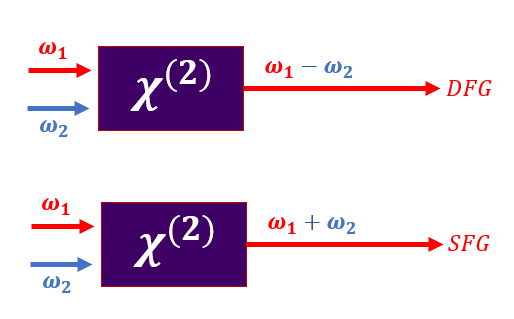

- Second Harmonic Generation (SHG) is a special case of Sum Frequency Generation (SFG) where two photons of the same frequency combine to produce a single photon with twice the frequency (or half the wavelength) of the input light. In this degenerate process, two identical photons from the fundamental beam are converted into one photon at the second harmonic through interaction with a nonlinear optical material.
The efficiency of this process depends critically on phase-matching conditions within the nonlinear crystal. SHG has become a widely used technique for generating new frequencies, particularly for accessing shorter wavelengths in laser systems and spectroscopic applications.
Raicol Crystals specializes in providing nonlinear crystals optimized for both DFG and SFG applications. By selecting the right material and engineering the crystal to meet specific wavelength requirements, Raicol ensures that DFG and SFG systems achieve high efficiency, precision, and stability. This makes their nonlinear crystals ideal for advanced laser systems requiring reliable and precise frequency control.
2. Which Nonlinear Crystals are Suitable for DFG and SFG?
- The efficiency of DFG and SFG processes depends significantly on the nonlinear crystal’s properties, including its nonlinear coefficient, damage threshold, and phase-matching capabilities. Commonly used nonlinear crystals for DFG and SFG include Potassium Titanyl Phosphate (KTP), Beta Barium Borate (BBO), and periodically poled lithium niobate (PPLN). These materials offer excellent nonlinear properties, high damage thresholds, and thermal stability in various wavelength ranges.
Raicol Crystals specializes in high-quality oxide-based nonlinear crystals, such as these, that are designed to handle high power, high efficiency, and thermal stability in laser systems. Additionally, Raicol’s ability to offer customized solutions means that customers can select the optimal material tailored to their specific DFG and SFG needs. Whether it’s for medical diagnostics, industrial applications, or defense systems, Raicol’s products ensure maximum performance in frequency generation applications.
3. How do Nonlinear Crystals Enhance DFG and SFG Efficiency?
- The efficiency of DFG and SFG heavily relies on the properties of the nonlinear crystal, such as its nonlinear coefficient, transparency range, and phase-matching capabilities. For maximum efficiency, the crystal must support the specific phase-matching conditions for the wavelengths of the input beams.
Raicol Crystals leverages over 50 years of expertise in crystal growth to provide customized solutions that enhance DFG and SFG efficiency. Their nonlinear crystals are optimized for high conversion efficiency, low losses, and the ability to handle high-power lasers. Raicol’s advanced manufacturing processes ensure that each crystal is precisely engineered to support the phase-matching conditions, allowing for superior performance in demanding applications.
Raicol’s tailored solutions enable clients to achieve the best possible output from their DFG and SFG systems, improving efficiency and ensuring reliable, high-quality results, particularly in critical industries like defense, aerospace, and medical diagnostics.
4. Why Choose Raicol Crystals for DFG and SFG Applications in Industrial and Defense Sectors?
- Raicol Crystals is a global leader in manufacturing nonlinear crystals, with deep expertise in the specific requirements of the defense and industrial sectors. Their advanced crystal solutions enable high-performance systems essential for applications like advanced radar, laser weapons, and high-resolution spectroscopy.
By offering customized nonlinear crystals that are engineered to meet the specific needs of these industries, Raicol ensures that its customers can achieve the precision and reliability required for mission-critical systems. Whether you’re designing next-generation defense technologies or enhancing industrial laser applications, Raicol’s nonlinear crystals provide the high performance necessary for success.
5. How Raicol Crystals Supports Medical Field with DFG and SFG Applications?
- In the medical field, DFG and SFG processes are used in non-invasive imaging techniques. The ability to generate precise wavelengths through these frequency generation methods enables improved resolution and sensitivity in medical imaging systems, making them valuable tools for diagnostics.
Raicol Crystals manufactures nonlinear optical crystals that are ideal for DFG and SFG applications in medical imaging. Their customized crystals ensure high frequency conversion efficiency, enhancing the performance of optical diagnostic devices. By optimizing the wavelength conversion process, Raicol’s crystals improve the clarity and accuracy of medical images, aiding in better diagnostic procedures and patient outcomes.
Conclusion: Why Raicol Crystals is the Optimal Choice for DFG and SFG Applications Difference Frequency Generation (DFG) and Sum Frequency Generation (SFG) play critical roles in many of today’s advanced optical technologies. For industries like defense, aerospace, medical, and industrial applications, the performance of DFG and SFG systems is intrinsically linked to the quality of the nonlinear crystals used.
Raicol Crystals, with over 50 years of expertise in crystal growth and a proven track record of providing high-quality nonlinear optical crystals, is the ideal partner for your DFG and SFG applications. Their commitment to precision, customized solutions, and high-performance products ensures that your frequency generation systems operate at peak efficiency and deliver optimal results.
Whether you’re enhancing the performance of existing laser systems or developing cutting-edge technologies, Raicol Crystals provides the knowledge, technology, and products needed to succeed.
Explore Raicol’s range of nonlinear optical crystals and electro-optical components to take your DFG \SFG systems to the next level.
Do you have a question? Our experts will be happy to hear from you and advise you on the best product for you. Contact Us.
Have you already subscribed to our YouTube channel? Don’t miss out—subscribe now for exclusive content and updates from our company.
